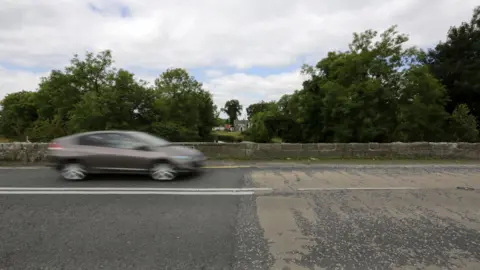Brexit: Why are border arguments delaying a deal?
 Alamy
AlamyThe future of the border between Northern Ireland and the Republic remains a sticking point in the Brexit negotiations. BBC Reality Check explains.
This is all about the border, isn't it?
Yes, borders are not just about security checks, tariffs and customs duties.
When two countries (in this case the UK and the Republic of Ireland) are both members of the European Union, and therefore in the single market and the customs union, then many rules and regulations on both sides of the border are identical.
That doesn't mean all rules are the same (think of speed limits in miles per hour or kilometres per hour for example) but a huge number of basic standards are. That means you don't have to check standards at the border because you know they are the same to start with.
So what are the rules and regulations we're talking about here?
Over the summer, Brexit negotiators identified more than 140 areas of "north-south co-operation" that would be affected by Brexit in one way or another.
Many of them are issues associated with cross-border trade in the agricultural sector - things like food safety and animal welfare. Energy is another important issue (there is an all-Ireland electricity market) - so too is transport (safety standards on cross-border routes) and the medical sector (the same rules governing things like prescriptions and medical devices).
All of them are regulated under the umbrella of common EU legislation.
If Northern Ireland, along with the rest of the UK, starts changing its regulations after Brexit, then problems start to arise.
But the language is pretty confusing. At one point, the Irish government was asking for "no regulatory divergence". Now the dispute seems to be about "continued regulatory alignment".
What's the difference?
If you start from the point we're at right now, with all these rules and regulations the same, then "no divergence" implies that Northern Ireland would not be able to change them at all. It would have to remain the same as the Republic of Ireland (and the wider EU).
Alignment implies something slightly different - two similar systems running in parallel could be aligned, but be different in some respects. So it is language which produces a little more wiggle room.
Irish Prime Minister Leo Varadkar said he thinks both phrases mean the same thing. If other parties think they mean something slightly different and honour is satisfied - well, that's the kind of creative ambiguity that sometimes makes international negotiations work.
But then politics gets in the way?
Yes. Everyone says they want to avoid the return of a "hard" border (a border where there is some kind of physical infrastructure and some kind of checks).
But they all have slightly different solutions.
The Irish government want a guarantee that regulations will remain broadly the same; the DUP doesn't want Northern Ireland to be treated any differently from the rest of the UK; Scotland, Wales, London and probably several others want special treatment themselves; and the EU is left wondering whether the UK government can square the circle.
 PA
PASo what are the potential compromises?
Either you try to limit the alignment of regulations to a few specific issues including some of those which fall under the terms of the 1998 Good Friday Agreement, the document on which the Northern Ireland peace process is based. (The Irish government wants a written guarantee that any agreement on the border respects the terms of the Good Friday Agreement.)
Or you declare that you will try to ensure that some form of regulatory alignment eventually refers to the whole of the UK, not just to Northern Ireland.
But option one would mean that Northern Ireland was being treated slightly differently which might be unacceptable to the DUP (on whom Theresa May is dependent for her parliamentary majority). And option two would upset Brexit supporters (on whom Theresa May is also dependent for her parliamentary majority) who argue that one of the main aims of Brexit was to be able move away from the EU's regulatory framework.
Many in the EU think the heart of the problem is that by insisting that there should be a) no hard border b) no UK membership of the single market and the customs union and c) no checks of any kind between Northern Ireland and the rest of the UK, the government in Westminster has set up a series of fundamentally incompatible red lines.
For everyone politics has come home to roost.
So what could happen next?
In various past negotiations - both in Northern Ireland and more generally in the EU - a form of words to satisfy all sides has been found at the eleventh hour. That could well happen again - but, don't forget, the aim at the moment is only to reach "sufficient progress" in the negotiations.
If a deal is declared this week or next, that is by no means the end of the story.
The UK government insists that if an ambitious trade agreement can be agreed with the EU in the future, then all of these detailed concerns about the Irish border will melt away.
Mr Varadkar has also said an EU-UK trade agreement allowing free trade to continue is his preferred option.
But until that happens the border will remain a fundamental part of the Brexit negotiations for some time to come.


